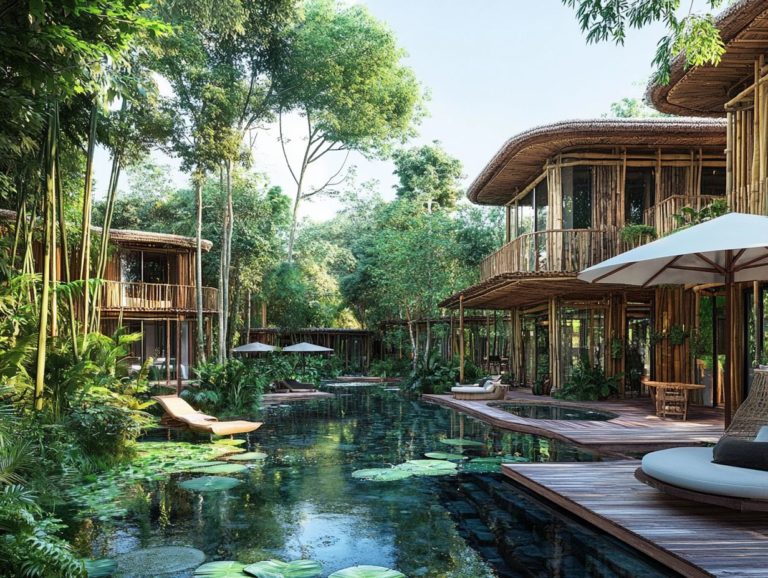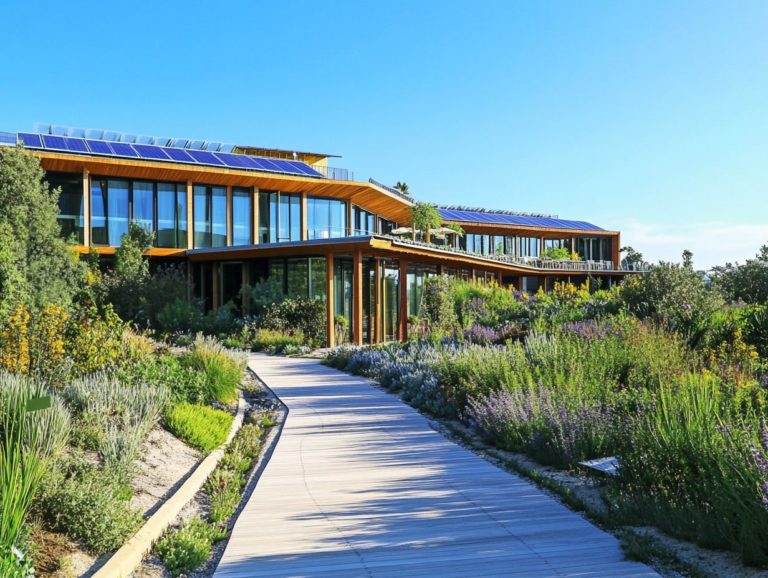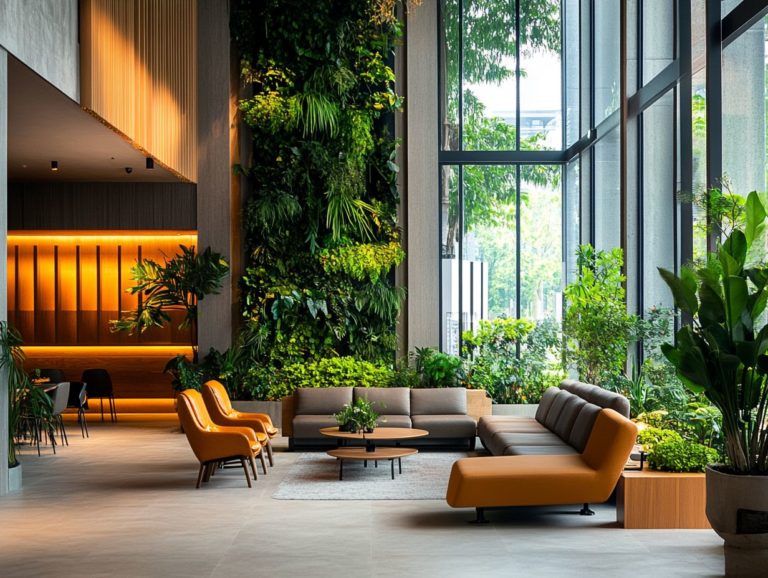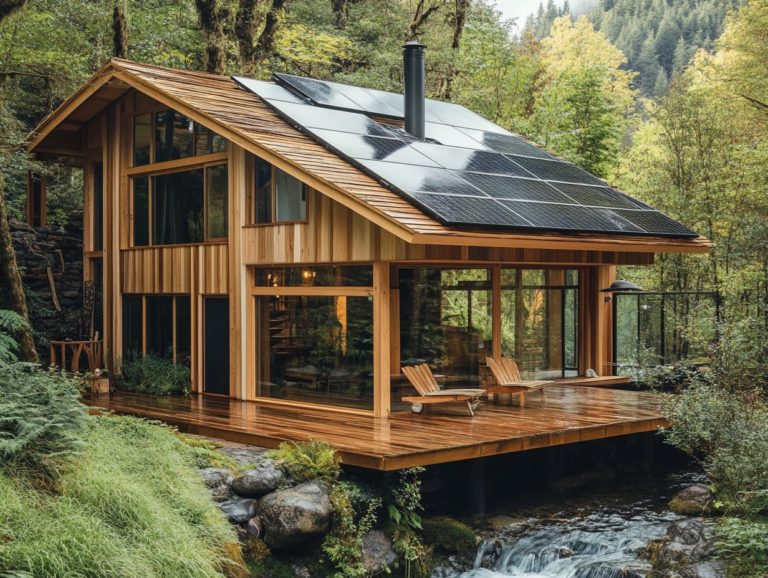Eco-Friendly Stays Near National Parks
Light quality is essential to the health and growth of your plants and houseplants, affecting everything from photosynthesis to blooming.
Different types of light, whether it s natural sunlight or artificial sources, can have distinct effects on how your plants develop. Consider factors like the distance from the light source and the duration of exposure, as these further influence light quality.
This article delves into how you can measure and evaluate light quality, offering valuable insights on how to optimize it for various plant types. Discover how to elevate your gardening or indoor planting experience with the right lighting strategies!
Contents
- Key Takeaways:
- Why is Light Quality Important?
- Types of Light and Their Effects on Plants
- Factors Affecting Light Quality
- Measuring and Evaluating Light Quality
- Optimizing Light Quality for Different Plants and Houseplants
- Frequently Asked Questions
- What is light quality and why is it important for plants?
- How does light quality impact photosynthesis in plants?
- How can I measure light quality for my plants?
- What is the ideal light quality for indoor plants?
- How can I improve light quality for my plants?
- Does the season affect light quality for outdoor plants?
Key Takeaways:
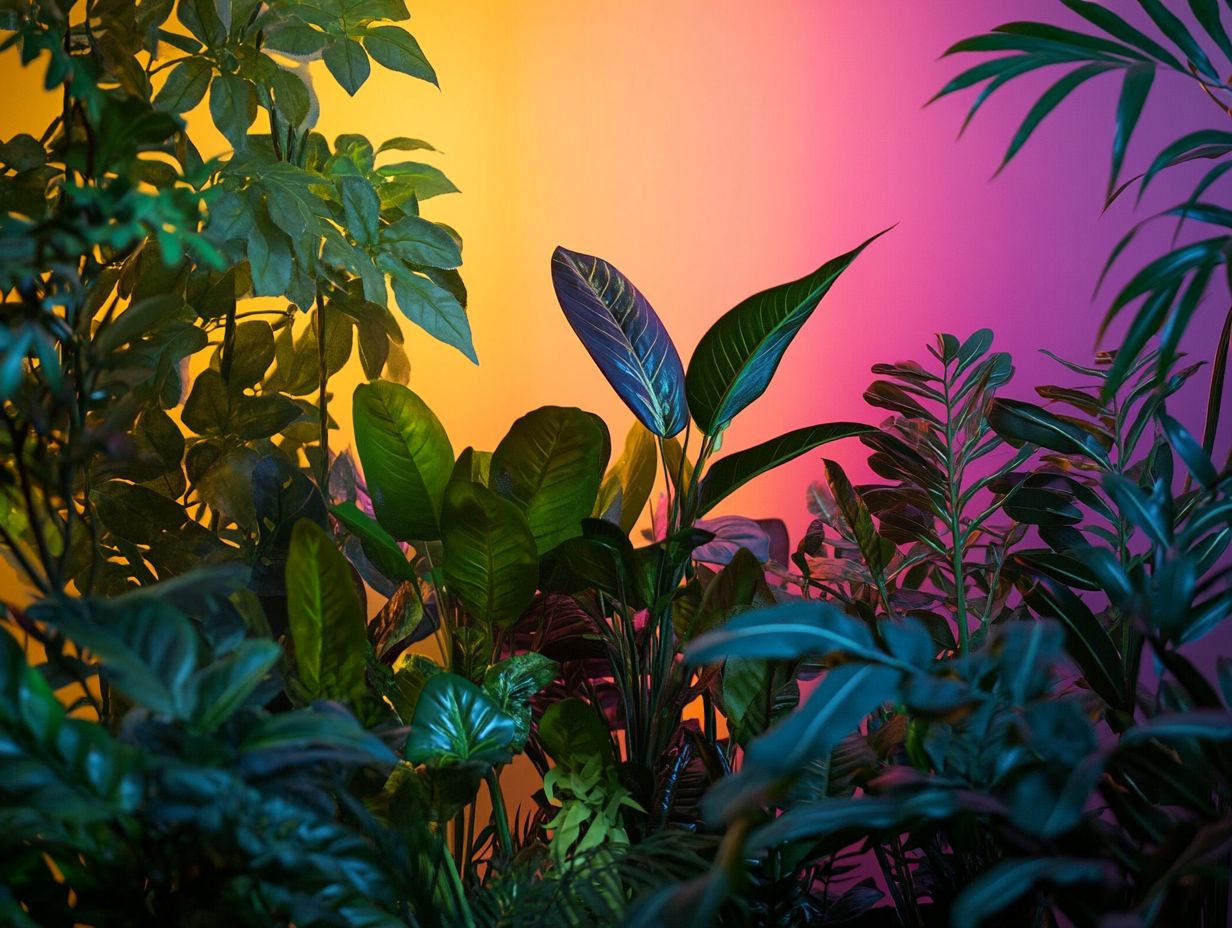
- Understanding the importance of light quality is crucial for healthy plant growth and development.
- Both natural and artificial light sources have different effects on plants, and factors like distance and duration of exposure also play a role.
- You can measure light quality in different ways to find the best lighting for your plants.
Why is Light Quality Important?
Grasping the significance of light quality is essential for nurturing vibrant plants and houseplants, as it directly influences the process of photosynthesis, vital for their growth and overall vitality. You may not realize it, but different light levels can profoundly affect how your plants flourish.
Factors like brightness, duration, and quality are not just minor details; they play crucial roles in your plants health. As Darryl Cheng highlights in his book, The New Plant Parent, ensuring optimal light conditions can substantially boost the growth and well-being of a diverse range of plants, whether they re basking in the glow of north-facing or south-facing windows.
Types of Light and Their Effects on Plants
When tending to houseplants, it s crucial for you to grasp the two main types of light natural sunlight and artificial light sources and how they impact different plants.
Natural sunlight typically stands out as the superior choice, offering bright, indirect light that many plants thrive on. You can customize artificial light to mimic natural sunlight, making it an excellent alternative for environments with limited light, such as north-facing spaces.
Natural Sunlight
Natural sunlight is the best friend your plants could ask for! It plays a vital role in the photosynthesis process that fuels their growth and energy production.
The intensity and angle of sunlight change with the seasons and your geographical location, directly affecting how plants adapt to their surroundings.
Take sun-loving champions like succulents and sunflowers, for instance. They flourish in bright, direct sunlight.
These resilient plants have evolved thicker leaves and reflective surfaces, enabling them to withstand intense light exposure while minimizing water loss and protecting themselves from the heat.
As the day transitions with the changing light of dawn and dusk, many plants cleverly adjust their leaf orientation to optimize light absorption. This showcases their extraordinary ability to harness energy throughout the day.
By grasping these adaptations, you can develop a deeper appreciation for the critical role that natural sunlight plays in the growth and sustainability of diverse plant species.
Artificial Light Sources
Artificial light sources, like grow lights, are popular for indoor gardening. They help houseplants that struggle to get enough natural sunlight.
You can customize these lights to deliver specific light levels, whether it s bright indirect light or low light. This perfectly caters to the unique needs of various plant species.
Among the most common types of artificial lights are LED and fluorescent options. LEDs are known for their energy efficiency and longevity.
They emit the ideal light spectrum that encourages robust growth. Fluorescent lights, while less energy-efficient, offer a wider array of color temperatures, making them versatile for many indoor plants.
When choosing the right type of artificial light, consider the specific light intensity requirements of your houseplants. Think about their growth stages and overall placement in your home.
Understanding these factors helps create an environment that fosters healthy growth and vibrant foliage. Your indoor garden can become a flourishing oasis!
Factors Affecting Light Quality

Several factors can influence the quality of light for your houseplants. These factors include the distance from the light source, the duration of light exposure, and any potential obstructions.
Understanding these variables is key for optimizing light conditions. This knowledge nurtures healthy growth across various plant species.
Distance from Light Source
The distance from the light source is crucial for your plants’ health and growth. If plants are too far away, they may become leggy. Conversely, being too close may lead to light burn.
For example, succulents thrive within 12 inches of bright light, as their thick leaves store water well. Meanwhile, ferns prefer indirect sunlight, so keeping them about 2 to 3 feet from a window provides the gentle light they need.
To boost growth, use adjustable light fixtures and rotate your plants regularly for even exposure. Using reflectors can also improve light efficiency and create a well-lit environment tailored to each plant’s needs.
Duration of Light Exposure
The duration of light exposure is vital for optimal quality for your houseplants. It directly affects photosynthesis and overall plant health.
Different plants, such as ferns and rubber plants, thrive under varying light conditions. Ferns prefer low to moderate indirect light and can get scorched leaves if exposed to direct sunlight.
Rubber plants enjoy bright, indirect light for best growth but can adapt to lower light, although this may slow their progress. Regularly rotating your plants encourages even growth.
Using sheer curtains can soften harsh sunlight while allowing adequate light duration. You can also use grow lights during shorter winter days to mimic natural light cycles, supporting your plants healthy development.
Measuring and Evaluating Light Quality
Measuring and evaluating light quality is essential for creating ideal conditions for plant growth. Tools like a light meter help you assess light intensity and quality accurately.
Understanding terms like PAR (Photosynthetically Active Radiation) and PPF (Photosynthetic Photon Flux) is important for all plant lovers. Knowing these concepts helps you cultivate thriving plants and maximize their potential.
PAR and PPF
PAR (Photosynthetically Active Radiation) is the light that plants use to make food, while PPF (Photosynthetic Photon Flux) measures how much of that light reaches a specific area. Understanding these concepts allows you to optimize light conditions for your houseplants.
PAR covers the range of light wavelengths from 400 to 700 nanometers. PPF quantifies the total amount of PAR in a specific area, expressed in micromoles per second. For example, fluorescent lights emit a narrower spectrum, while LED grow lights can be customized to provide a broad spectrum, meeting the needs of various houseplants.
Grasping the relationship between light sources, PAR, and PPF helps you choose lighting systems that effectively promote healthy plant growth and vibrant foliage, including understanding the impact of light quality.
Spectrum Analysis
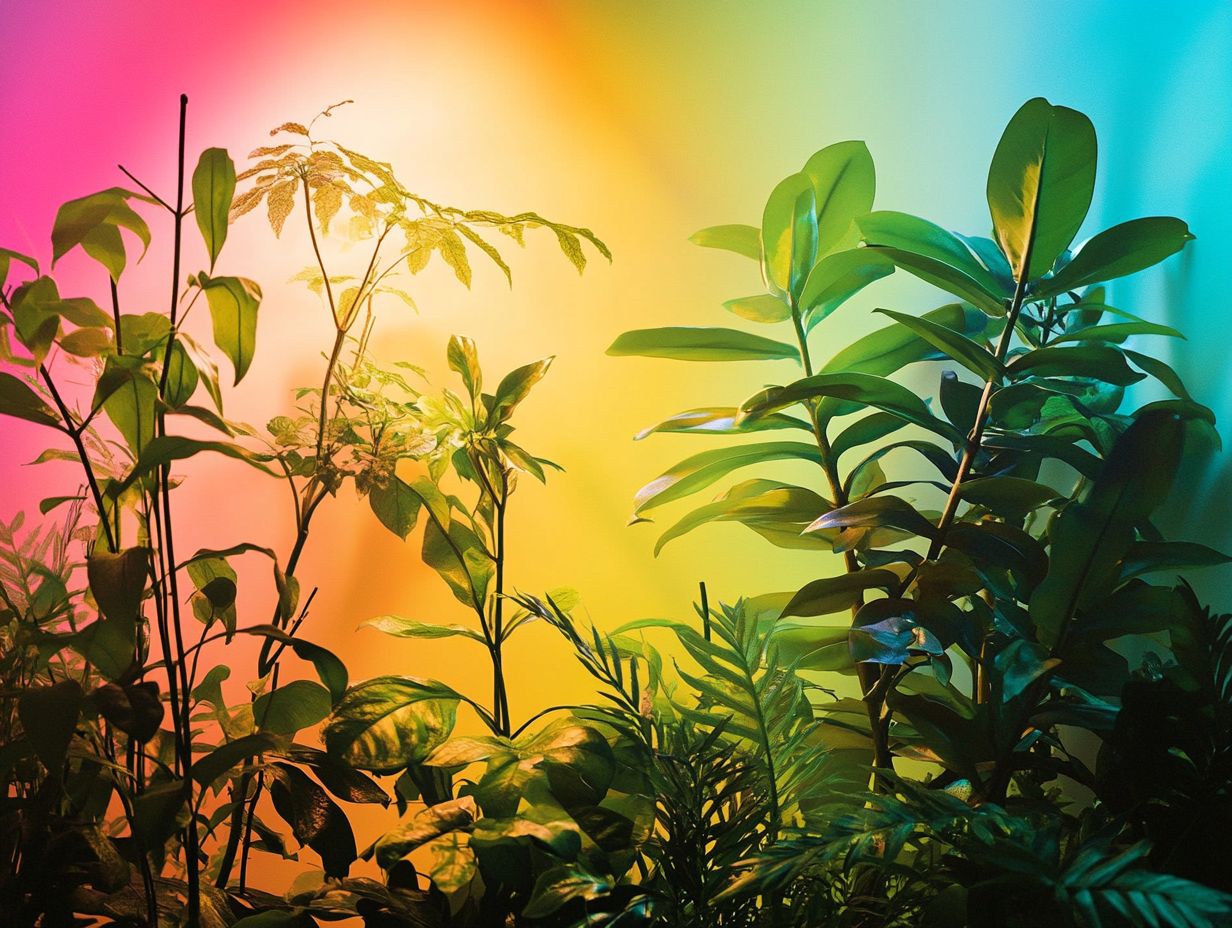
Spectrum analysis is an important method for evaluating light quality. It helps you identify the wavelengths of light your plants absorb for photosynthesis.
As you explore various wavelengths, you’ll find that not all plants thrive under the same lighting. Some species flourish with increased blue light for strong vegetative growth, while others depend on red light for flowering and fruiting.
This knowledge helps you fine-tune light conditions. Ensure each plant receives the appropriate amount and quality of light for its unique developmental stages. Leveraging this insight, such as understanding the light spectrum for plants, can lead to healthier plants and enhanced yields, transforming your gardening experience.
Optimizing Light Quality for Different Plants and Houseplants
Optimizing light quality involves understanding your plants’ individual light needs whether they thrive in bright indirect light, low light, or direct sunlight.
By tailoring these conditions to each plant’s needs, you can boost their health and growth, creating a vibrant indoor garden filled with diverse houseplants.
Light Requirements for Different Types of Plants
Different plants have unique light requirements. Some thrive in bright indirect light, while others are content in low light or basking in direct sunlight. Understanding these needs is crucial for gardening success.
Take the snake plant, for example. Its resilience allows it to flourish in low to bright indirect light, making it a great choice for dim corners or spots near windows that avoid direct sunlight.
ZZ plants are champions of low-light conditions, ideal for offices or rooms with minimal natural light.
If you want to showcase a vibrant hibiscus, remember it craves bright, direct sunlight to thrive. Placing it near a south-facing window or an east-facing window will yield the best results.
Adjusting plant locations based on their preferences and using grow lights when necessary ensures healthy growth and elevates your space’s beauty.
Frequently Asked Questions
What is light quality and why is it important for plants?
Light quality refers to the specific wavelengths and colors of light that plants receive. It plays a crucial role in photosynthesis, as different wavelengths affect plant growth and development in various ways.
Start analyzing your plant’s light needs today for a thriving indoor garden!
How does light quality impact photosynthesis in plants?
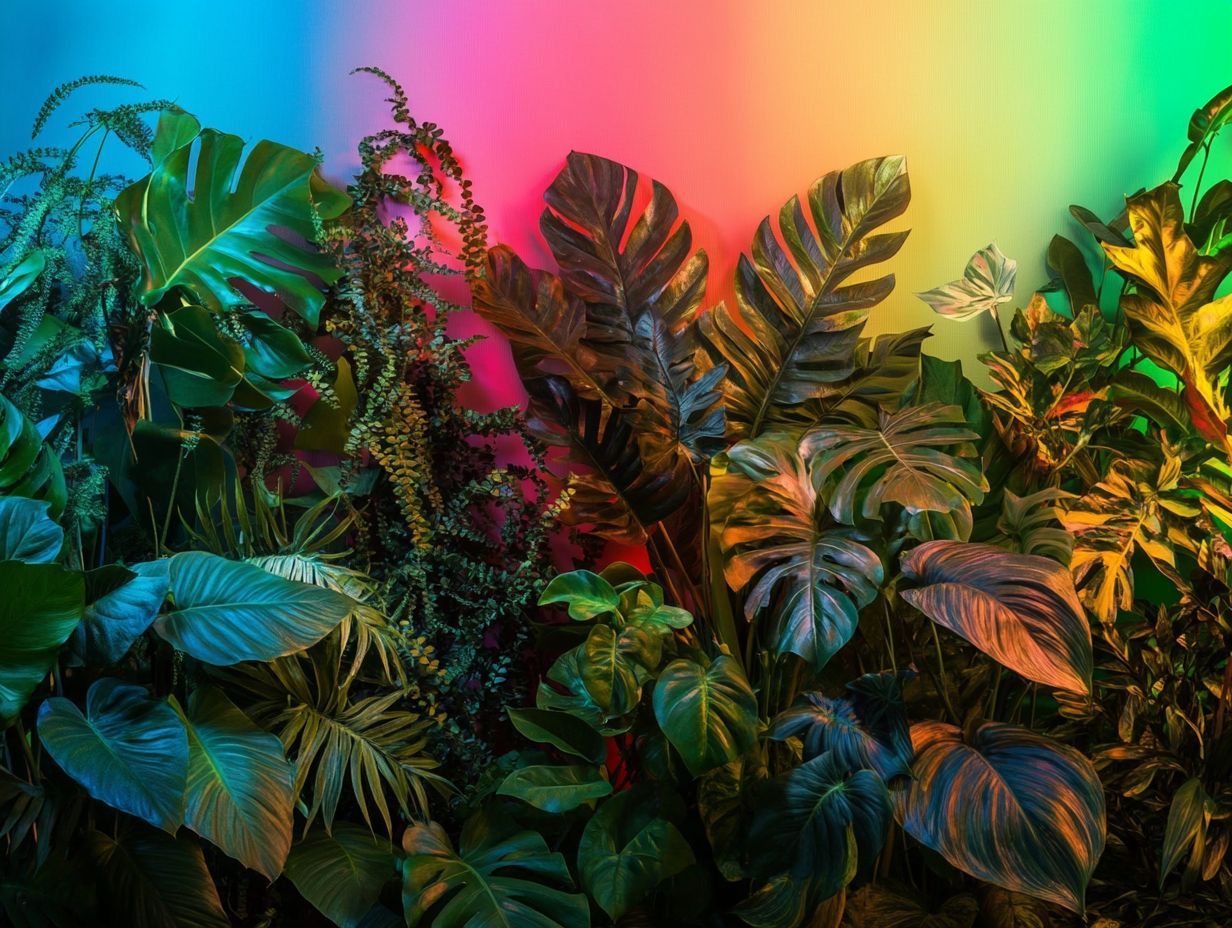
Light quality impacts the rate of photosynthesis in plants. Different wavelengths of light are absorbed and used at varying rates.
Red and blue light are most effective for photosynthesis. Green light is less effective, making a light meter beneficial for measurement.
How can I measure light quality for my plants?
You can measure light quality using a spectrometer. Alternatively, a light meter designed for plants measures light in various wavelengths.
What is the ideal light quality for indoor plants?
The ideal light quality for indoor plants varies by type. Generally, a mix of red and blue light is most beneficial for houseplants like Chinese evergreen and Norfolk Island pine.
You can achieve this mix with natural sunlight and artificial grow lights. This combination optimizes growth conditions.
How can I improve light quality for my plants?
To improve light quality, use grow lights designed for plants. Adjusting the position and distance of your lights can also help.
Providing a mix of red, blue, and green light is recommended by gardening experts like Darryl Cheng in The New Plant Parent.
Does the season affect light quality for outdoor plants?
Yes, the season affects light quality for outdoor plants. Plants needing specific light conditions, like Amaryllis, can be impacted.
In summer, plants receive intense direct sunlight. However, in winter, the light is weaker and often contains more red and blue wavelengths, affecting growth and flowering.

